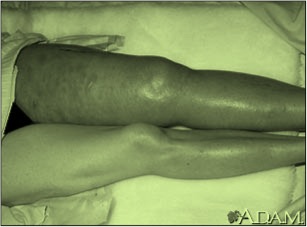Just How Common are Total Hip or Knee Replacement Surgery Blood Clots?
The serious complications rate during hip or knee replacement surgery is a bit more than 10% and some of these side effects are blood clots. However, the number of blood clots that are caused by joint replacement surgery are likely under reported, as the only blood clots that get treated are those that become symptomatic and problematic. In addition, some of these are likely caught after the patient leaves the hospital, so they aren’t reported in hospital based data that ends up in research studies. So how under-reported are hip and knee replacement surgery blood clots?
This recently published study may surprise you. These researchers used the latest blood clot detecting technology (multi-detector computed tomography (MDCT)) to scan every patient before and after hip or knee replacement for this common complication. They found asymptomatic blood clots in the legs in 8%of patients before surgery (makes sense, as many of these patients are less active and elderly). However, after hip or knee replacement surgery, blood clots in the legs that produced symptoms were found a whopping 34% of patients! If you add in the blood clots that didn’t produce symptoms the number climbs to a staggering 51%! While some of these blood clots may not need to be treated, the big risk for these patients is pulmonary embolus or PE (a blood clot in the lung that can be fatal). Treating this 1/2 of patients to prevent a PE makes sense, since these are the patients at higher risk of having a blood clot in their leg travel to their lungs.
Planning a knee or hip replacement surgery? You may want to discuss with your surgeon that he or she use this technology to check for blood clots after surgery.

If you have questions or comments about this blog post, please email us at [email protected]
NOTE: This blog post provides general information to help the reader better understand regenerative medicine, musculoskeletal health, and related subjects. All content provided in this blog, website, or any linked materials, including text, graphics, images, patient profiles, outcomes, and information, are not intended and should not be considered or used as a substitute for medical advice, diagnosis, or treatment. Please always consult with a professional and certified healthcare provider to discuss if a treatment is right for you.

